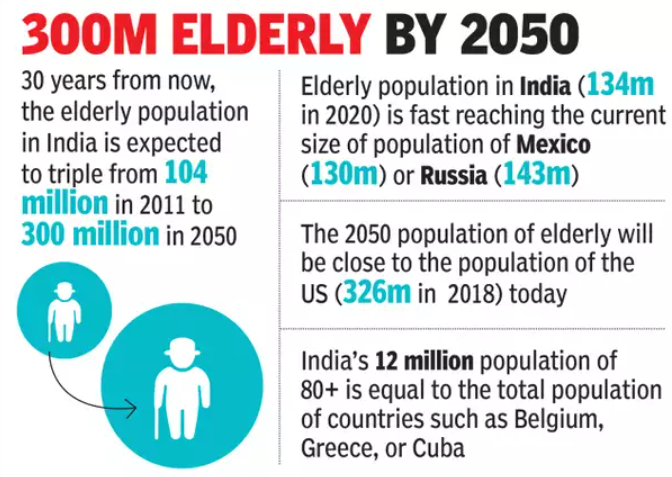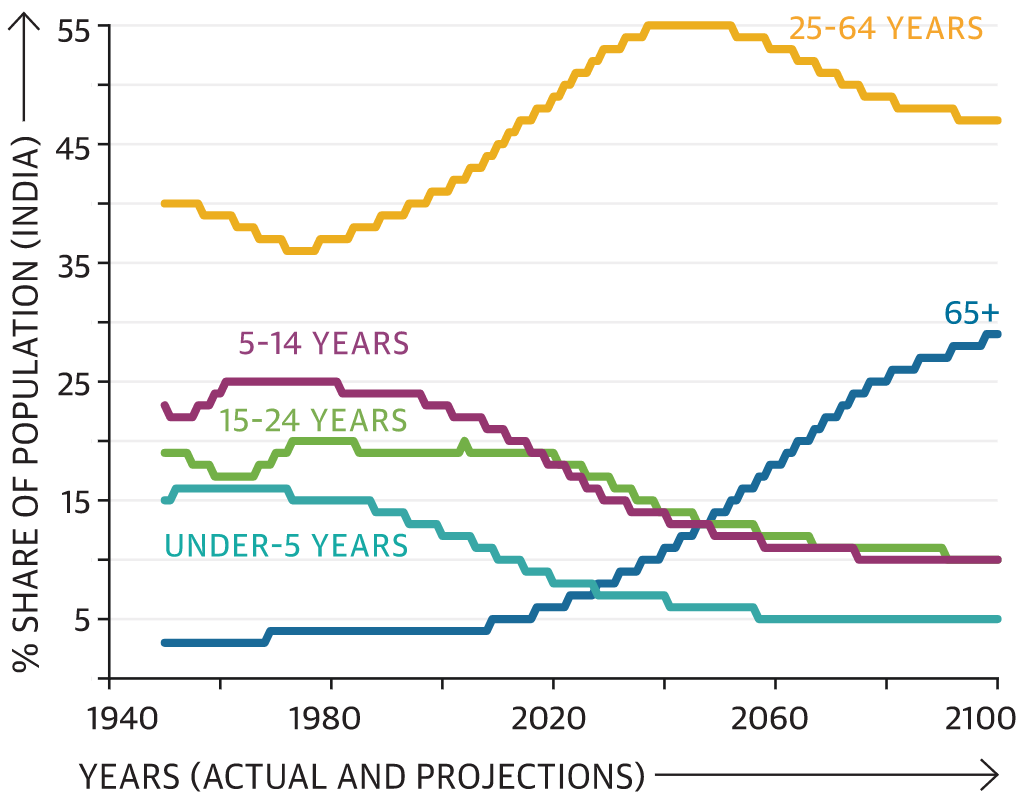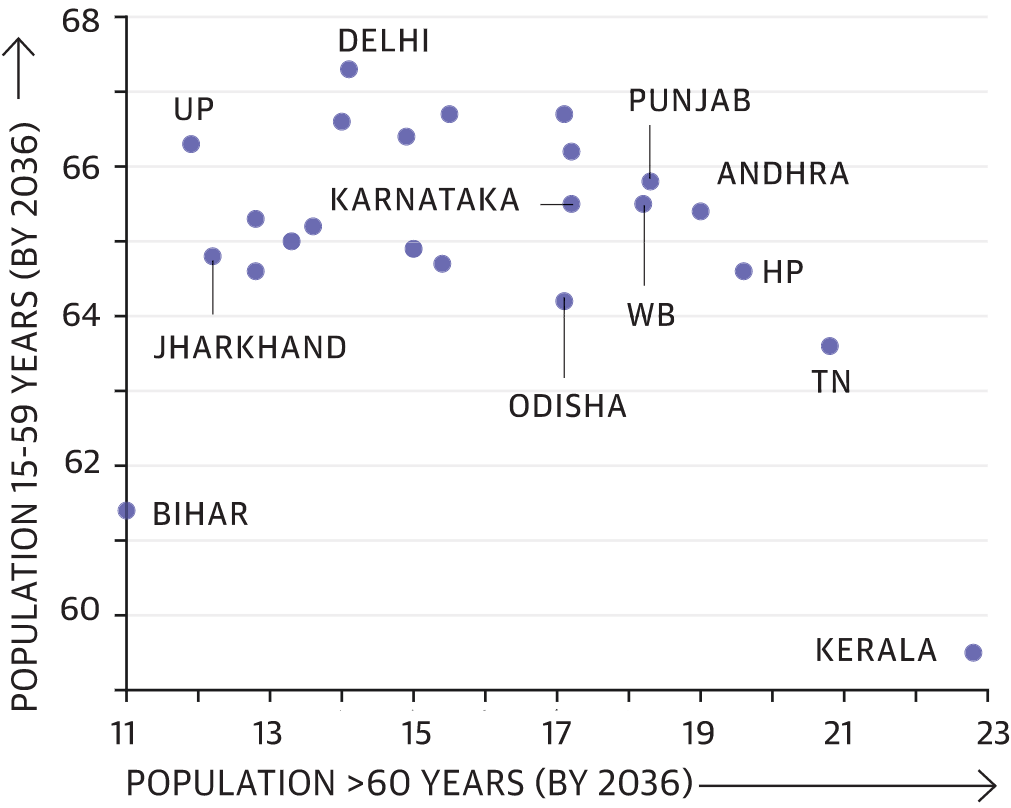Old age poverty in India
2022 SEP 15
Mains >
Social justice > Human Resources > Vulnerable & Backward sections
IN NEWS:
- The share of elderly (persons aged 60 years and above) in India’s population, close to 9% in 2011, is growing fast and may reach 18% by 2036 according to the National Commission on Population. This calls for a discussion on old age poverty.
STATISTICS:

- Life expectancy in India has more than doubled since Independence: from around 32 years in the late 1940s to 70 years today. Over the same period, the fertility rate has reached to two per woman. While this is good news, it also creates a new challenge of ageing population.
- The elderly population (aged 60 years or above) in India accounted for 8.6% of the total population in 2011. Of this, 53 million are females and 51 million are males.
- This number is expected to increase by 40% to 195 million in 2031, and 300 million by 2050.

- There is also stark regional variation in old age population. States that attained population stability earlier, like the southern states, have a larger old age population compared to other States.

GOVERNMENT EFFORTS:
- National Policy on Older People (NPOP):
- It envisages State support to ensure financial and food security, health care, shelter and other needs of older persons, equitable share in development, protection against abuse and exploitation, and availability of services to improve the quality of their lives.
- The policy also covers issues like social security, intergenerational bonding, family as the primary caretaker, role of Non-Governmental Organizations, training of manpower, research and training.
- National Programme for Health Care of Elderly (NPHCE):
- It is an articulation of the International and national commitments of the Government as envisaged under the UN Convention on the Rights of Persons with Disabilities (UNCRPD)
- Components:
- Access to promotional, preventive, curative and rehabilitative services to the elderly through community based primary health care approach
- Build capacity of the medical and paramedical professionals as well as the care-takers within the family for providing health care to the elderly.
- Provide referral services to the elderly patients through district hospitals, regional medical institutions
- Convergence with National Rural Health Mission, AYUSH and other line departments like Ministry of Social Justice and Empowerment.
- National Social Assistance Programme (NSAP):
- Under which old-age pensions and family benefits are provided to BPL families.
- Maintenance and Welfare of Parents and Senior Citizens Act, 2007:
- Elderly who cannot support themselves can demand maintenance for their children.
- Also, the Act legally empowers the elderly to claim their property back from their children if the condition of maintenance is not satisfied.
- SAGE (Seniorcare Aging Growth Engine) initiative and SAGE portal:
- SAGE is aimed at promoting private enterprises to bring out innovation in products to benefit elders. The SAGE portal will be a “one-stop access” of elderly care products and services by credible start-ups.
- It was brough out based on the recommendations of the Expert Group on silver economy.
|
Silver economy is the system of production, distribution and consumption of goods and services aimed at using the purchasing potential of older and ageing people and satisfying their consumption, living and health needs.
|
- Atal Pension Yojana:
- The subscribers would receive the fixed pension of Rs 1,000 – Rs 5,000 per month from the age of 60 years onward, depending on their contribution.
- This would prevent the economic compulsion to work in the later years of life.
- Health Insurance for Senior Citizens:
- Rs 100 billion of unclaimed funds under EPFO and Small Savings would be utilised for providing health insurance cover to the elderly.
- National Institute of Social Defence (NISD):
- It undertakes the development of a cadre of geriatric caregivers in the family and community for the welfare of older persons.
- Certificate course on geriatric bedside assistance and care-giving, certificate course in geriatric care for voluntary agencies, dementia-care programmes
- South Asia Partnership on Ageing:
- The Kathmandu Declaration 2016 (under SAARC) reaffirms commitments to the Older Peoples’ Rights enshrined in the Vienna International Plan of Action on Ageing, the United Nations Principles for Older Persons.
- UN Decade of Healthy Ageing (2021–2030):
- It is a global collaboration, aligned with the last ten years of the Sustainable Development Goals, that brings together governments, civil society, international agencies, professionals, academia, the media, and the private sector to improve the lives of older people, their families, and the communities in which they live.
CONCERNS OVER OLD AGE POVERTY:
- Rise in dependency ratio:
- A national survey carried out by the NGO HelpAge India has shown that as many as 47% of elderly people are economically dependent on their families for income and 34% are relied on pensions and cash transfers. The situation was even worse for males. (52nd round of NSSO).
- Health concerns:
- Physical:
- As per the Longitudinal Ageing Study in India (LASI), 11% of the elderly suffer from at least one form of impairment (locomotor, mental, visual and hearing). Cardiovascular disease (CVD) prevalence is estimated to be 34% amongst 60-74 years.
- Mental:
- As per LASI, one in five elderly persons in India has mental health issues. The proportion with depression symptoms is much higher for women than men.
- Fiscal cost:
- An aging population and slower labor force growth affect economies in many ways—the growth of GDP slows, working-age people pay more to support the elderly, and public budgets strain under the burden of the higher total cost of health and retirement programs for old people.
- Isolation & violence:
- Mobility of younger generation and growth of individualism are leading to the breakdown of the joint family structure. Also, an overwhelming proportion of the elders are from the lower socio-economic strata. This is exposing the elderly to emotional and physical insecurity.
- Under-utilization of human resource:
- Despite their valuable experience and willingness to work, elderly population is finding it increasingly difficult to get reliable work.
- Low penetration of social security:
- Coverage of measures like insurance and pensions remain limited. For instance, despite 13 years after National Pension Scheme (NPS) only 2% of roughly 400 million informal sector workers have opted for it.
- By 2050, if this situation is allowed to continue, India will have nearly 300 million elderly without pension benefits.
- Deficiencies in public health system:
- India has a major deficit in infrastructure and skilled medical care resources, with 1.3 hospital beds, 0.65 physicians, and 1.3 nurses for every 1,000 people. Over the next decade, we have the potential to add more than 3 million beds, 1.54 million doctors and 2.4 million nurses.
- Lack of specialised healthcare:
- Geriatric care is relatively new in many developing countries like India with many practicing physicians having little knowledge of the clinical and functional implications of aging
- Most of the government facilities such as day care centres, old age residential homes, counselling and recreational facilities are urban based.
- Issues with physical infrastructure:
- Most spaces in homes and public spaces are insensitive to elderly needs. Lack of access to assistive equipment makes the thing worse.
- Lacunae in implementation:
- The 2007 law requires States to ensure earmarked facilities for elders in every district hospital, headed by a doctor with experience in geriatric care. Yet, a status report filed by the Government in the Supreme Court of India in 2019 stated that 16 States and Union Territories did not have a single ward/bed dedicated to elders.
WAY FORWARD:
- Change outlook:
- Rather than considering the elderly as dependents, policymakers must look at them as a potential asset: a massive resource of experienced, knowledgeable people.
- Invest in health and care services to the elderly:
- Considering the demographic trends, India should reimagine its entire health-care policy for the next few decades, with an elderly prioritised approach.
- They require an array of specialised medical services at home including tele or home consultations, physiotherapy and rehabilitation services, mental health counselling and treatment, as well as pharmaceutical and diagnostic services.
- The Ayushman Bharat and PM-JAY ecosystems need to be further expanded and similar, special health-care coverage schemes and services need to be created for senior citizens from the lower economic strata.
- The National Digital Health Mission has tremendous potential to expand medical consultations into the interiors of the country.
- Capacity building:
- Converting them from dependents to productive members requires upgrading their capabilities. For this, investments in skill development, digital literacy and
- Inclusive infrastructure:
- Creation of a network of old age homes, both in the private and public sector
- Guidelines for making public infrastructure accessible to old age people with necessary assistive supports
- Value education:
- To inculcate the moral obligation upon the children to take care of their parents, we need to incorporate values and ethics in school curriculum.
BEST PRACTICE:
- ‘Vayomithram’ by Government of Kerala:
- This scheme aims to provide health care and support to elderly residents in the corporation/municipal areas.
- The project mainly provides free medicines through mobile clinics, palliative care and a help-desk to the old.
- The project is implemented in collaboration with the urban local bodies (municipalities).
- Kerala Police Janamaithri Suraksha:
- The police help to monitor the senior citizens by interacting with them on phone, visiting them regularly, organizing field visits and advising them on their personal problems.
PRACTICE QUESTION:
Q. ‘If India is to ensure good quality of life for the elderly in the near future, planning and providing for it must begin today’. Discuss in the context of aging population in India?


